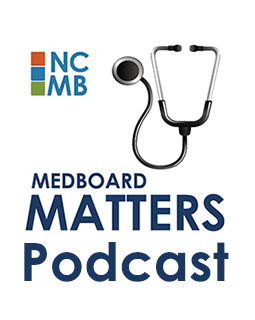The NCMB hosted a roundtable discussion on Physician Wellness, with particular emphasis on burnout, on June 17. The event brought together medical professionals and other interested parties across medicine to discuss the subject and brainstorm ways for the Board to support licensees. This productive meeting confirmed that finding ways to nurture personal and professional resilience while guarding against the destructive phenomenon of burnout should be a priority for any organization invested in the future of medicine and quality patient care. The Board’s ultimate concern is to protect the public from the negative effects of burnout.
Burnout is defined as “emotional and physical exhaustion resulting from a combination of exposure to environmental and internal stressors and inadequate coping and adaptive skills,” according to the Miller-Keane Encyclopedia and Dictionary of Medicine, Nursing, and Allied Health. The person with burnout exhibits an “increasingly negative attitude toward his or her job, low self-esteem, and personal devaluation.”
What’s more, the problem seems to be getting worse for American physicians. The 2015 Medscape Physician Lifestyle Report, a survey of approximately 20,000 US physicians, found a significant increase from the 2013 survey in the percentage of respondents who described themselves as burned out (46 percent in 2015, compared to 40 percent in 2013). This feature excerpts key findings from the 2015 Medscape survey.
Findings are published with permission: Peckham C. Physician Burnout: It Just Keeps Getting Worse; Medscape Family Medicine; January 26, 2015. Available at: www.medscape.com/viewarticle/838437
Nearly half of all physicians burned out: 46% of Medscape survey respondents reported burnout
Total burned out, by gender: 51% Female, 43% Male
Most burned out specialties: Critical Care 53%, Emergency Medicine 52%, Family Medicine 50%
Least burned out specialties: Dermatology 37%, Mental Health 38%, Pathology 39%
Burnout starts early: 44% of physicians age 35 and under reported burnout
Leading contributors to burnout
#1 Too many bureaucratic tasks: Pretty simple math here. Too much compliance and documentation related work and too little time actually providing patient care – you know, the reason most people become physicians.
#2 Too many hours at work: Get physicians some work-life balance, stat.
#3 Not enough income: Increasing from 5th to 3rd from 2013 to 2015. Prospects aren’t looking up, with significant Medicare payment cuts on the horizon and, for the first time this year, penalties for failing to show the federal government “meaningful use” of electronic health records (EHR).
#4 Increased computerization: Lots of physicians are singing the EHR blues, citing steep learning curves and frustration associated with adopting new systems and a corresponding loss of face-to-face time with patients.
#5 Impact of the Affordable Care Act: Related to #1, but big enough on its own to warrant a specific mention from Medscape survey respondents. The ACA dropped from 3rd in 2013 to 5th in 2015.
Protective factors against burnout
Time off: Specifically, vacations. 70 percent of physicians who reported they were not burned out indicated they took more than two weeks of vacation a year. Physicians reporting burnout were less likely to take the same amount off (just 59 percent did).
Excellent Health: 70 percent of physicians who are not burned out report they are in excellent health. Just 54 percent of doctors who are burned out say the same. 68 percent of non burned-out physicians and 56 percent of burned-out physicians report exercising at least twice a week.
Maintaining a healthy weight: Which came first, the weight gain or the burnout? Not sure, but physicians who describe themselves as burned out are more likely to be overweight or obese. (46 percent compared to 39 percent, according to the Medscape survey.)
Marriage: The highest rates of burnout among respondents occurred in physicians who had never been married and lived alone. The lowest rates of physician burnout were seen among widows and widowers at 37 percent, followed by physicians who are either remarried (44 percent) or in a first marriage (45 percent).
Resources: ways to focus on the positive
Three good things: A popular way to help ward off professional burnout is the “Three Good Things” exercise. Developed by psychologist Martin Seligman, Ph.D, this simple but effective activity takes the individual’s focus off the negative and redirects it to specific things that are working well in that individual’s life and work.
Completing the exercise is simple:
1. Each night, before going to sleep, think about the good things that happened that day. Any good thing works – it could be having a positive interpersonal interaction with a colleague or something as simple as enjoying a perfect peach.
2. Write down three good things. Reflect on the factors that allowed these good things to happen. Write down explanations for why these good things happened – e.g. “I took the time to visit the Farmer’s Market over the weekend, where they have the best fruit.”
3. Repeat this exercise every night for at least a week. Over time, you will begin to focus on the positives in your life more easily.
Watch a one minute video of Seligman describing the exercise here.
Want more depth? Watch a TED talk by Seligman on the power of positive psychology here.
AMA offers free online CME on battling burnout, developing resilience
The American Medical Association recently launched a series of online interactive modules to address common practice challenges, including burnout. Physicians may access the free modules online at www.STEPSForward.org
There are two modules that specifically address physician wellness. Each completed module earns the participant a half-hour of Category 1 CME credit:
• Improving physician resilience
• Preventing physician burnout
The AMA plans to continue adding modules to the collection. More than 25 modules are expected to be available by the end of 2015.
